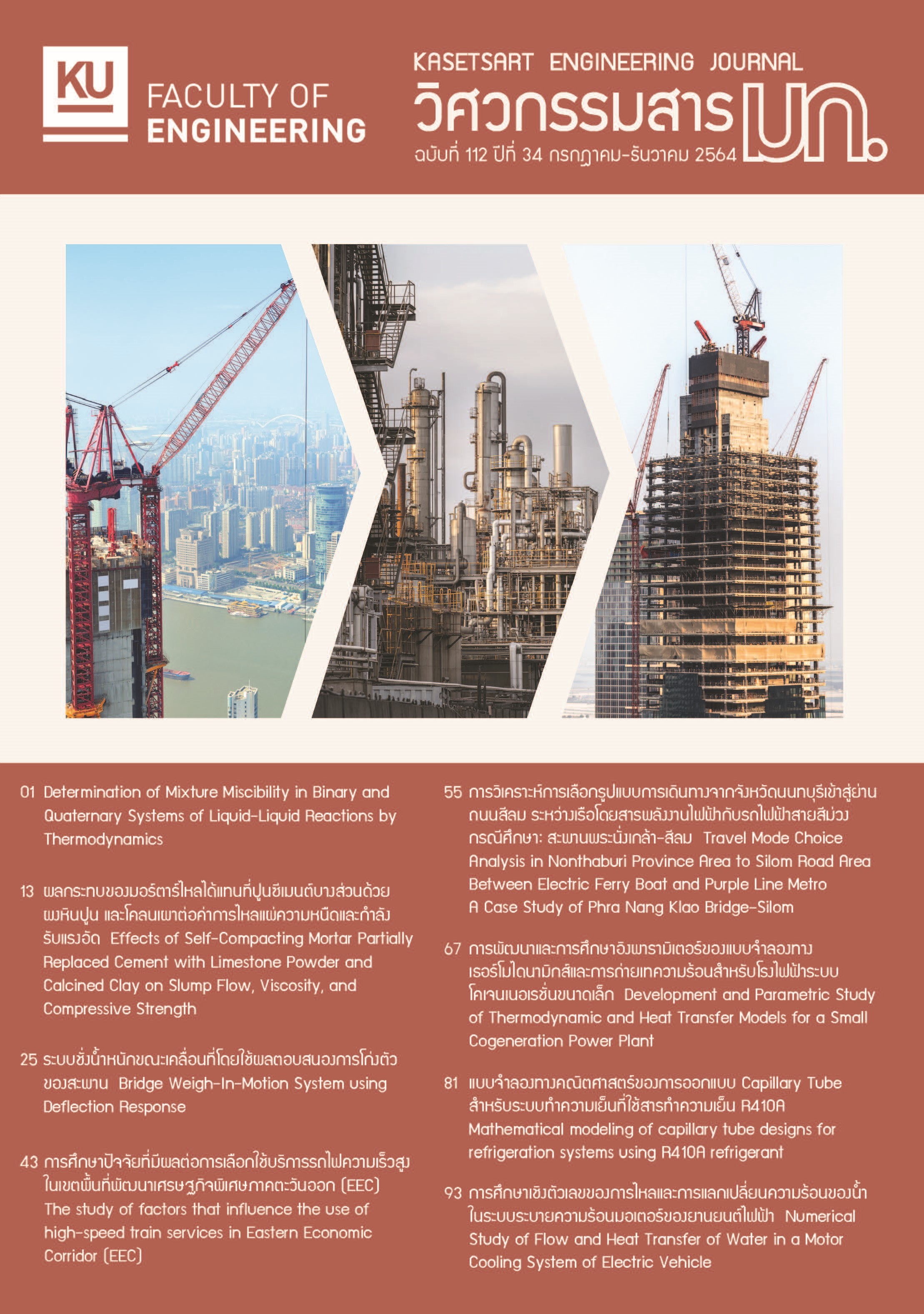Determination of Mixture Miscibility in Binary and Quaternary Systems of Liquid-Liquid Reactions by Thermodynamics
Keywords:
Phase equilibrium; Binary system; Quaternary system; Amidation; TransesterificationAbstract
An industrial chemical process commonly involves two types of chemical reaction systems: homogeneous and heterogeneous systems. Identification of mixing state is important in detail modeling of the system. This work focuses on determination of equilibrium mixing state for 3 liquid-liquid reaction systems: 2 types of amidation and transesterification. Each experimental system is binary with two components of reactants at the initial reaction time. As the reactions proceed, each system becomes quaternary with 4 components of 2 reactants and 2 products. The state of mixing of the systems was examined based on the change in dimensionless Gibbs free energy of mixing which was related to liquid activity coefficients. The coefficients were obtained from the UNIFAC method. The results show that the binary mixture of amidation is immiscible in almost all composition ranges except at low reactant concentrations while that of transesterification is immiscible for all compositions of mixture. The mole fraction values used in all systems at the initial reaction time indicate that the binary mixtures are immiscible. As the reactions proceed, the quaternary mixture of amidation is converted to miscible within a short reaction time period due to existing of surfactant produced from the reaction. On the other hand, the quaternary mixture of transesterification is still immiscible throughout the reaction time. At higher reaction temperature, the quaternary mixture of amidation requires a shorter time to convert from immiscible to miscible because of increased rate of surfactant production. The information of mixing state is important for choosing appropriate models in process analysis and design.
References
Denes F, Lang P, and Lang-Lazi M (2006). Liquid-Liquid-Liquid Equilibrium Calculations. IChemE, 152: 877-890.
Novak J P, Mautous J, and Fick J (1987). Liquid-liquid equilibria. Amsterdam, NL: Elsevier.
Wilson G M (1964). Vapor-Liquid Equilibrium. XI. A New Expression for the Excess Gibbs Energy of Mixing. J. Am. Chem. Soc, 86: 127-130.
Renon H J, and Prausnitz M (1968). Local composition in thermodynamic excess functions for liquid mixtures. AIChE J., 14: 135-144.
Aage F, Russell L J, and John M P (1975). Group-Contribution Etimation of Acitivity Coefficients in Nonideal Liquid Mixtures. AIChE J., 21: 1086-1098.
Steen S, Barbel K, Jürgen G, and Peter R (1979). Vapor-Liquid Equilibria by UNIFAC Group Contribution. Revision and Extension. Ind. Eng. Chem. Process Des. Dev., 18: 714-722.
Hui Z, Houfang L, and Bin L (2006). Solubility of Multicomponent Systems in the Biodiesel Production by Transesterification of Jatropha curcas L. Oil with Methanol. J. Chem. Eng. Data, 51: 1130-1135.
Xuejun L, Xianglan P, Yujun W, and Shenlin Z (2008). Liquid–Liquid Equilibrium for Systems of (Fatty Acid Ethyl Esters + Ethanol + Soybean Oil and Fatty Acid Ethyl Esters + Ethanol + Glycerol). J. Chem. Eng. Data, 53: 359–362.
Mohsen M and Mahdi D (2007). Liquid-Liquid Equilibrium for Systems of (Corn Oil+Oleic Acid+Methanol or Ethanol) at (303.15 and 313.15) K. J. Chem. Eng. Data, 52: 910-914.
Masoume R, Sona R, Maziyar M and Masoud N (2013). Liquid-Liquid Equilibria in Biodiesel Production. J Am Oil Chem Soc, 90: 147-154.
Francisca M R M, Filipe X F, Nathan E S, Rílvia S de S-A, and Hosiberto B de S (2011). Liquid-Liquid Equilibrium for Ternary Mixtures of Biodiesel (Soybean or Sunflower) + Glycerol + Ethanol at Different Temperatures. J. Chem. Eng. Data, 56: 4061-4067.
Xin H, Jingtao B, Jingkang W, Jinbo O, Yan X, Hongxun H, Ying B, Yongli W, and Qiuxiang Y (2015). Liquid–liquid equilibrium of binary and ternary systems composed by palm oil or palm oil fractions with methanol/ethanol and water. Fluid Phase Equilibria, 404: 17-25.
Sujitra T, Terasut S, Atichat W, and Aroonsri N (2017). Equilibrium study for ternary mixtures of biodiesel. In: Proceeding of InCITE, Bali, Indonesia. 273: 1-7.
Cintia B G, and Antonio J A M (2004). Liquid–liquid equilibrium data for the system palm oil + fatty acids + ethanol + water at 318.2 K. Fluid Phase Equilibria, 221: 139-150.
Amaraporn K, Siriluck P, and Attasak J (2016). Transesterification of palm oil in a microtube reactor. The Canadian Journal of Chemical Engineering, 94: 859-864.
Smith J M, Van Ness HC, and Abbott MM. Introduction to Chemical Engineering Thermodynamics. The McGraw-Hill, NY: USA.
Bruice PY (2006). Essential Organic Chemistry. New Jersey: Pearson Education.
Downloads
Published
Issue
Section
License

This work is licensed under a Creative Commons Attribution-NonCommercial-NoDerivatives 4.0 International License.


